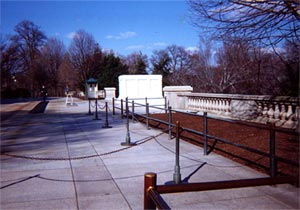
|
On March 4, 1921, the 66th Congress approved Public Resolution 67
to honor an unknown American killed in war. Although the measure to
approve the Tomb was introduced by Congressman Hamilton Fish, Jr.
of New York, credit for the idea belongs to France and England, who
were the first nations to bestow such honors on unknown casualties.
The idea reached America via Brigadier General William D. Connor.
Gen. Connor was the commanding general of American forces in
France
and learned of the French project as it was being planned.
The area in front of the Memorial Amphitheatre is now the final resting
place of three unknown soldiers. The unknown from WWI was buried
on
the 11th of November 1921. His tomb was initially a sub base and
a
base, slightly smaller than the present base.
He was selected at random out of 4 bodies exhumed from each of the
four American cemeteries in France - Aisne-Maine, Meuse-Argonne, Somme,
and St. Mihiel. The unknown soldiers of WWII and the Korean War were
both buried on May 30, 1958. The WWII soldier was chosen
at random
from two unidentified bodies - one from Europe and one from the Pacific.
The soldier from the Korean War was chosen at random from the National
Cemetery of the Pacific in Hawaii. The unknown soldier from Vietnam
was exhumed from his crypt at Arlington in 1998 to undergo DNA testing.
Scientist discovered the identity of the soldier to be AF
1st Lt.
Michael Joseph Blassie.
Lt. Blassie now lies buried at his family's
plot and it has been decided that the Vietnam crypt will remain empty.
Each body was thoroughly examined before buried to ensure that the
person had been a member
of the American military, had died of wounds
received in combat, and that there were no clues to his identity whatsoever.
Each soldier received the Medal of Honor.
Congress authorized the completion of the tomb and the building of
the superstructure on July 3, 1926. Seventy-four designs were submitted
and reviewed by the Arlington Cemetery Commission, American Battle
Monuments Commission, the Fine Arts Commission, and a small jury
of
other professionals. The winning design belonged to Mr. Thomas Hudson
Jones, sculptor, and Lorimer Rich, architect, of New York City.
The material of the superstructure is Yule marble, a nearly pure calcite
marble with minor inclusions of mica, quartz, and feldspar. There
are irregularly shaped calcite grains ranging from 100 to 600 micrometers
in diameter.
The marble was quarried near the town of Marble in Gunnison
County, Colorado and is the same material used in the Lincoln Memorial.
The block quarried for the construction of the Tomb weighed 110 tons,
and was the largest block of marble ever produced in the U.S.
The tomb consists of seven pieces of rectangular
marble and is divided into four parts:
| 1. Sub-Base |
| |
4 pieces of marble
· 2 feet
by 6 inches in height
· 15 tons |
| 2. Base |
|
| |
1 piece of marble
· 14'11"
in length, 8' in width, and 1'10" in height
·
16 tons |
| 3. Die |
|
| |
1 piece of marble
· 12'3 ½"
in length, 6'4" in width, and 5'5" in height
·
36 tons |
| 4. Cap |
|
| |
1 piece of marble
· 12'7"
in length, 6'8" in width, and 1'1 ¾" in height
· 12 tons |
The east side of the tomb bears a relief of
three figures: Victory, Peace, and Valor. The number three signifies
the three Allied Powers of WWI. The north and south sides of the
tomb are divided into three panels by Doric pilasters. In the center
of each panel there is an inverted wreath. The six wreaths represent
the six major battle campaigns of WWI:
| 1. Ardenne |
4. Meusse-Argonne |
| 2. Belleauwood |
5. Oisiu-Eiseu |
| 3. Chateau-Terrie |
6. Somme |
Inscribed in the west side (facing the amphitheatre)
is the following:
HERE RESTS IN HONORED GLORY AN AMERICAN SOLDIER KNOWN BUT TO GOD
The author is unknown. The three crypts for the unknowns of WWII,
Korea, and Vietnam each consist of a marble slab created from the
same White Yule marble. Each slab weighs 3 tons measures 98 ¼"
x 42" x 10". The dates of each conflict are inscribed
in each accordingly:
1941 - 1945
1950 - 1953
1958 - 1975
The settling of the marble has created flaws.
A natural crack has developed around the entire tomb, about 3 feet
off the base, most likely from the weight of the 12-ton cap.
The Tomb is guarded 24 hours a day, 365 days a year by specially
trained members of the 3rd United States Infantry, The Old Guard.
More then 4 million people visit Arlington each year. Over 260,000
people are buried there, including soldiers, civilians, astronauts,
former slaves, presidents, judges, and explorers.
Back to page one: Tomb of the
Unknown Soldier
Top of Page
|

